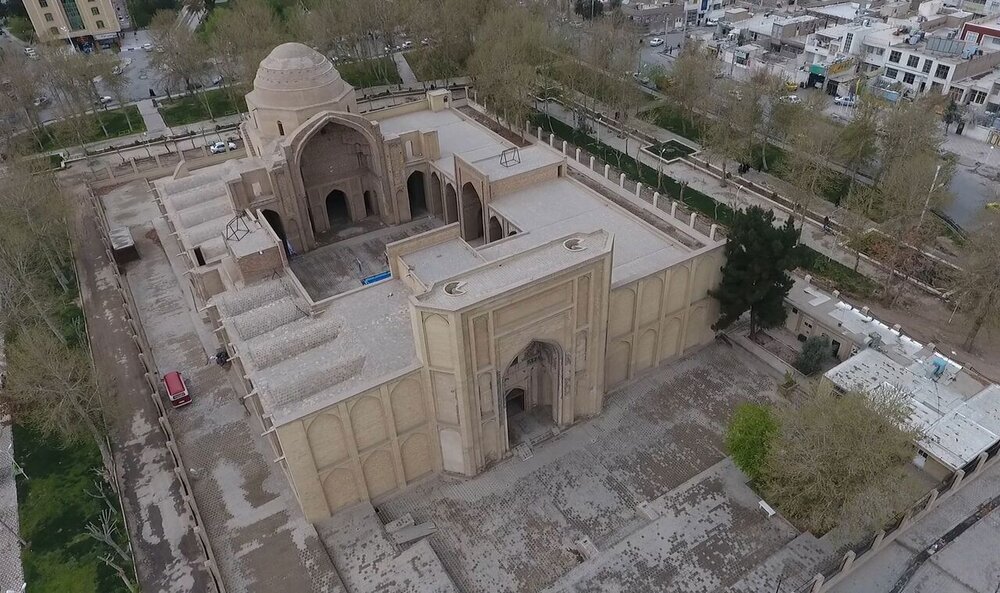See earliest surviving example of mosque constructed by Ilkhanids

TEHRAN – A destination for the faithful, sightseers, and historians near Tehran, the Congregational (Jameh) Mosque of Varamin is renowned as the earliest surviving example of a mosque constructed by the Ilkhanids in Iran.
The mosque’s decorative treatment is rich on the surface; the materials employed include plaster, glazed and unglazed terracotta, and glazed tile-mosaic work. A portal iwan of the mosque features glazed terracotta in dark and light blue, forming a geometric pattern on a background of unglazed terracotta.
Its sunburst dome features a medallion at its center, from which descends an arabesque of a diamond geometric motif that expands with the curve of the dome.
The terms “Jameh Mosque”, “Masjed-e Jameh” and “Friday Mosque” are used in Iran for a grand communal mosque where mandatory Friday prayers are performed: the phrase is used in other Muslim countries but only in Iran does it designate this purpose.
According to Archnet, an inscription traces its date of construction back to 722 AH (1322 CE) and names the original patrons as Muhammad ibn-i Muhammad ibn-i Mansur Quhadi and his son Hasan.
The mosque follows the four-iwan (portico) plan. On the qibla (south) side of the courtyard, a broad and shallow iwan with an arched muqarnas semidome leads onto a domed hall with a mihrab. The dome rises from a sixteen-sided drum with alternating windows, resting on an octagonal transitional area formed by four squinches. The height of the dome chamber, which rises above the height of the other iwans, accentuates this important space.
This impression of size is most prominent when one passes from the low vault of the iwan to the lofty space of the domed chamber. On either side of the domed hall, passageways lead onto Shabestans (covered prayer halls) supported by thick piers.
Arcades lining the east and west sides of the courtyard interrupted by larger iwans at their centers lead onto additional covered areas. The covered area on the east side of the courtyard is one aisle deep, while excavations revealed that the equivalent area on the west was two aisles deep, resulting in an asymmetric plan.
The mosque’s vault is constructed in such a way that tiers of bricks laid horizontally jut out to different degrees at different levels to form a semi-dome.
The qibla iwan before the dome chamber is decorated with richly ornamented geometric patterns in terracotta, above which an inscription band runs horizontally and marks the beginning of the iwan’s vault, which comprises a cluster of muqarnas units. These units are, in turn, constructed out of smaller bricks.
Intricate plaster floral and vegetal motifs decorate the mihrab’s niche as well as the wall surrounding its pointed arch.
An inscription band frames the mihrab’s portal, beyond which plaster spreads like a three-dimensional tapestry to cover the whole wall. The other three walls display geometric patterns in terracotta. In many areas, bricks are displayed so that they extend from the wall to highlight their sculptural qualities.
The spandrels of the arches of the four squinches feature glazed terracotta and incorporate in their vaults three tiers of muqarnas. Four windows are situated on the walls of the chambers, each between two squinches.
For most contemporary architectural historians, Jameh Mosque of Varamin continues to epitomize the first crystallization of a four-iwan mosque by the Il Khanids, but also monumentality achieved by the delicacy of ornament, the display of rich materials, and the play of light and shadow of the sculptural architectural elements.
The Ilkhanid dynasty, also called Il-Khanid, was a Mongol dynasty that ruled Iran from 1256 to 1335. Il-Khan is Persian for “subordinate khan.”
Hulegu, a grandson of Genghis Khan, received orders from the supreme Mongol chieftain Mongke to conquer Iran. Hulegu set out around 1253 with a Mongol army of about 130,000 men. He founded the Il-Khanid dynasty in 1256 and conquered Baghdad and all of Iran by 1258, according to Britannica.
The Il-Khanids consolidated their position in Iran and unified the region as a political and territorial entity after several centuries of fragmented rule by small dynasties. During the reign of the Il-Khanid Maumud Ghuzun (r. 1295-1304), the Il-Khanids lost all contact with the remaining Mongol chiefs in China. Mahmud Ghuzun himself embraced Sunni Islam, and his reign was a time of Iranian cultural renaissance in Iran, with scholars such as Rashid al-Din flourishing under his patronage.
Ghazan’s brother Oljeitu (r. 1304-16) converted to Shia Islam in 1310. Oljeitu’s conversion caused great unrest, and when he died in 1316, the civil war was imminent. His son and successor, Abu Sa’id (r. 1317-35), converted to Sunni Islam and was thus able to prevent a war.
During Abu Sa’id’s reign, however, factional disputes and internal unrest continued to spread. Abu Sa’id died without leaving an heir, and with his death, the unity of the dynasty was broken. Thereafter, various Il-Khanid princes ruled parts of the dynasty’s former territory until 1353.
AM
